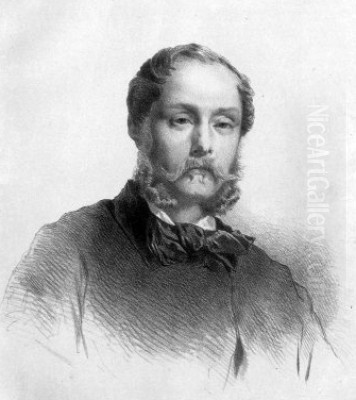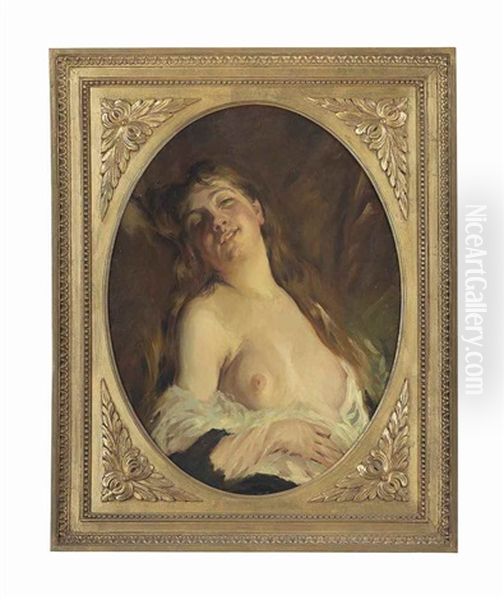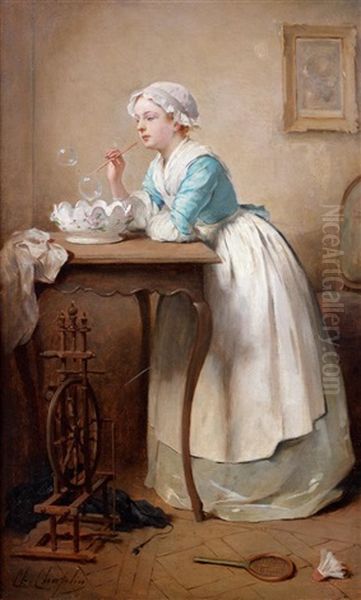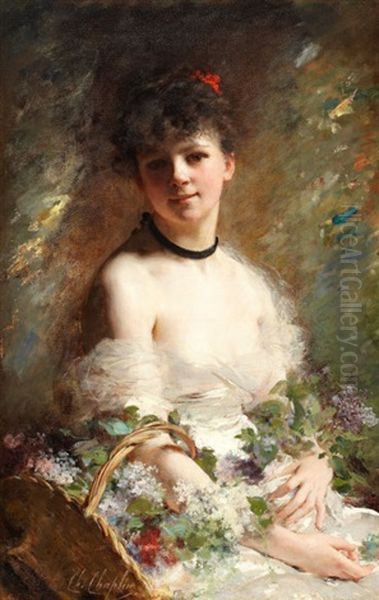
Charles Joshua Chaplin stands as a significant figure in 19th-century French art. A painter and printmaker of considerable renown, he carved a niche for himself with his graceful and often intimate depictions of young women. Though born in France to an English father and a French mother, he became a naturalized French citizen and spent his entire life contributing to the artistic landscape of his adopted homeland. His work, bridging academic tradition with a burgeoning modern sensibility, continues to charm viewers with its elegance and technical finesse.
Early Life and Artistic Formation
Charles Joshua Chaplin was born on June 8, 1825, in Les Andelys, located in the Eure department of France. His dual heritage, with an English father and a French mother, perhaps contributed to the unique blend of influences seen later in his work. His artistic inclinations led him to Paris, the epicenter of the European art world.
In 1840, Chaplin embarked on his formal artistic training by enrolling at the prestigious École des Beaux-Arts in Paris. There, he had the invaluable opportunity to study under Michel Martin Drolling, a respected painter known for his adherence to Neoclassical principles inherited from his own master, Jacques-Louis David. Drolling emphasized precision, strong composition, and anatomical accuracy, providing Chaplin with a solid academic foundation. Drolling himself came from an artistic family, his father being Martin Drolling and his sister Louise-Adéone Drölling.
During his time at the École des Beaux-Arts, Chaplin was part of a vibrant generation of artists. He studied alongside figures who would also achieve recognition, including Paul Baudry and Jean-Jacques Henner. Some accounts also place Jules Breton among his contemporaries under Drolling's tutelage. This environment fostered artistic exchange and development, shaping the young painter's path.
Chaplin made his public debut in 1845 at the highly influential Paris Salon. His first exhibited work was a portrait of his mother, a conventional yet significant step marking the beginning of his professional career. This initial foray into the public eye set the stage for his future successes and growing reputation within the Parisian art scene.
Evolution of Style: From Realism to Rococo Grace

Chaplin's artistic journey was marked by a distinct evolution in style. His early works, emerging in the period following the 1848 Revolution and during the Second Republic, reflected the prevailing taste for Realism. This movement emphasized the accurate and objective depiction of contemporary life and subjects, moving away from the idealized forms of Neoclassicism and the dramatic narratives of Romanticism.
However, Chaplin did not remain solely within the confines of Realism. Gradually, his style shifted towards a more elegant, supple, and sensuous manner. This transformation showed a clear affinity with the spirit of 18th-century French Rococo art, particularly the works of François Boucher. Boucher's influence can be seen in the delicate charm, soft palettes, and often playful or intimate themes that began to characterize Chaplin's paintings.
Further enriching his stylistic palette were influences from renowned British portraitists like Sir Joshua Reynolds and Thomas Gainsborough. These masters were celebrated for their elegant and sophisticated portrayals of the aristocracy, and their impact is discernible in the grace and refinement Chaplin brought to his own portraiture.
By the 1870s, Chaplin had largely focused his attention on the subject matter that would define his career: the portrayal of young women. His canvases often featured solitary female figures captured in moments of quietude or private activity – resting, reading, singing, engaging in their toilette, or lost in thought. He became known for his ability to render soft, pearlescent skin tones and capture a sense of youthful innocence, often tinged with a subtle, alluring sensuality.
While working during the rise of Impressionism, Chaplin was not an Impressionist painter in the strict sense. He did not adopt their revolutionary techniques for capturing fleeting moments of light and colour through broken brushwork. However, an indirect influence can perhaps be detected in his sensitivity to light effects, his delicate application of paint, and his preference for soft, harmonious colour palettes, which created a distinctive hazy and atmospheric quality in many of his best works.
Chaplin demonstrated remarkable technical versatility throughout his career. He was proficient not only in oil painting but also worked adeptly in pastel, watercolour, and chalk. Furthermore, he was a skilled printmaker, producing etchings and lithographs, showcasing his command over line and tone in different media.
Major Works, Recognition, and Patronage

Chaplin's talent did not go unnoticed. His success at the Paris Salon continued after his debut. A significant milestone came in 1851 when he received an award at the Salon. This recognition helped solidify his reputation and brought him to the attention of Parisian high society, including the aristocracy. Consequently, he began receiving numerous commissions, particularly for portraits, which further enhanced his standing.
His growing fame led to prestigious commissions beyond private portraiture. In 1861, Chaplin was entrusted with a significant decorative project: painting ceilings and panels for the Salon des Fleurs (Salon of Flowers) in the Tuileries Palace in Paris, the residence of Empress Eugénie, wife of Napoleon III. This commission placed him among the favoured artists of the Second Empire.
Among his most celebrated and representative works are paintings that perfectly encapsulate his mature style. "Rêverie" (Reverie) is often cited as a quintessential Chaplin piece, depicting a young woman lost in thought, embodying the gentle charm and delicate execution characteristic of his work. Another well-known painting is "Les Bulles de Savon" (Soap Bubbles), a charming genre scene that showcases his lighter, more playful side and his skill in capturing everyday moments with grace.
"The Pearl Necklace" is another signature work, focusing on the theme of feminine adornment and quiet intimacy. Genre paintings like "Young Woman with Flower Basket" further demonstrate his mastery of light, colour, and texture, creating visually appealing and emotionally resonant images. His early "Portrait of the Artist's Mother," exhibited in 1845, remains important as the work that launched his public career.
Later in his career, his work in printmaking also gained attention, though sometimes in unexpected ways. An etching titled "Shepherd of the Cevennes," created around 1885, later became entangled in a case involving art forgery, highlighting the reach and recognition of his work even in graphic media.
Chaplin as an Educator: Nurturing Female Talent
Beyond his own artistic production, Charles Joshua Chaplin made a significant contribution to art education, particularly for women. At a time when opportunities for female artists to receive professional training were limited, Chaplin opened his studio to women, offering dedicated art classes. This was a progressive step and provided crucial training for aspiring female painters.
His role as a mentor proved highly influential. Among his most famous students was the American artist Mary Cassatt. Cassatt, who would become a key figure in the Impressionist movement, studied with Chaplin and undoubtedly benefited from his guidance, even as she developed her own distinct style focusing on the lives of women and children.

Another notable student was the British artist Louise Jopling (referred to in some sources, possibly erroneously, as Louise Loring). Jopling achieved considerable success as a portrait painter in London. French artist Louise Abbéma, known for her portraits (including famous depictions of Sarah Bernhardt) and decorative panels, is also listed among his pupils in some accounts. Chaplin's teaching helped launch the careers of these and other women artists, fostering a generation of female talent.
His commitment to teaching women underscores a significant aspect of his career, positioning him not just as a successful painter but also as an important facilitator of artistic development for a group often marginalized within the official art establishment of the time.
Later Life, Anecdotes, and Legacy
Chaplin continued to be active in the art world throughout his later years. He officially became a French citizen in 1865 (though some sources cite 1886, the earlier date appears more frequently in timelines), formally cementing his ties to the country where he had spent his entire life and career.
Despite his considerable success and popularity, personal writings suggest moments of ambivalence towards his work. A manuscript letter from 1890, written while he was working in Bayeux, reveals a surprisingly candid glimpse into his mindset. He expressed a certain lack of pride in his ongoing work, attributing his motivation partly to boredom and the financial necessity of paying for a new house. This anecdote offers a humanizing counterpoint to his public image as a celebrated artist.
Charles Joshua Chaplin died in Paris on January 30, 1891 (some sources incorrectly state 1918), at the age of 65. He was buried in the Père Lachaise Cemetery in Paris, a resting place for many prominent figures in French arts and culture.
His legacy endures primarily through his paintings, which remain popular for their undeniable charm and technical skill. He is remembered as a master of the elegant and idealized female form, capturing a specific sensibility favoured during the French Second Empire and Third Republic. His work successfully blended the rigorous training of the French Academy with a softer, more modern aesthetic influenced by Rococo and British portraiture.
Furthermore, his role as a dedicated teacher, especially to women artists like Mary Cassatt and Louise Jopling, marks a significant contribution to the history of art education. Charles Joshua Chaplin remains an important figure for understanding the complexities of 19th-century French art, navigating the transitions between academicism, realism, and the emerging modern movements, all while creating a body of work defined by its enduring grace and elegance.